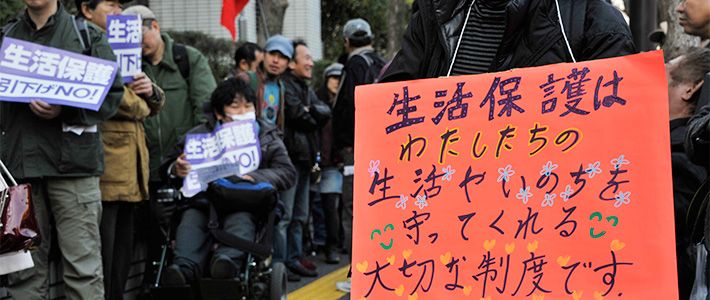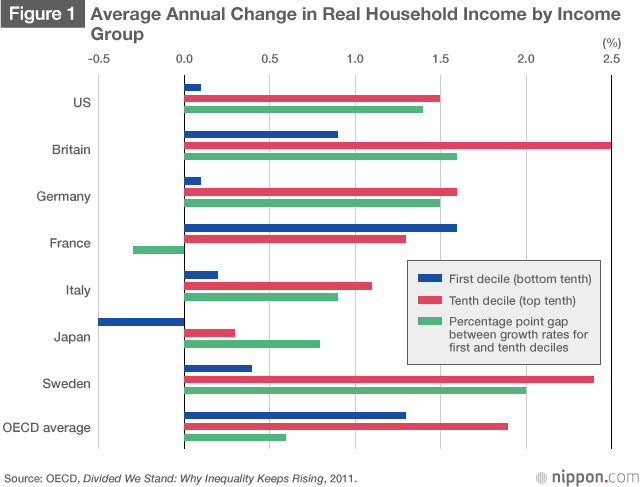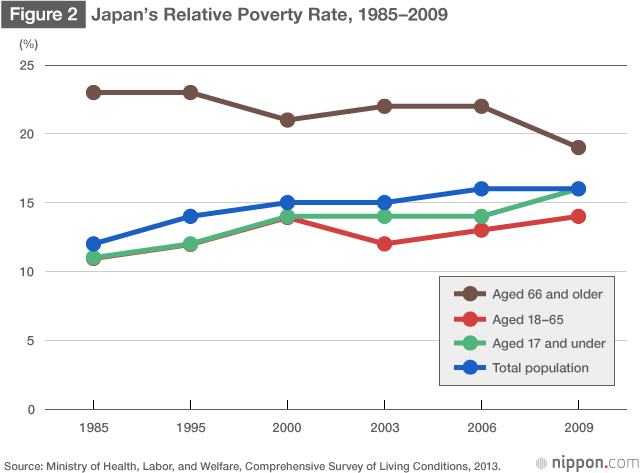
Japan’s Welfare Policies at the Crossroads
Wrestling with Poverty and Income Inequality
Economy Society- English
- 日本語
- 简体字
- 繁體字
- Français
- Español
- العربية
- Русский
Japan’s welfare rolls have swollen dramatically in recent years. In December 2014, the number of needy persons receiving public assistance, known in Japan as livelihood protection (seikatsu hogo), topped 2.17 million, a new post–World War II high. While about 40% of the households receiving such benefits consist of elderly individuals or couples, younger recipients are also on the rise.
In short, Japan has a pressing poverty problem. Yet politicians continue to clash over the efficacy of income redistribution versus growth-oriented policies, and public opinion vacillates according to the prevailing social conditions and the tenor of media coverage.
In 2007 and 2008, the nation was shocked by reports of elderly citizens who had starved to death after their welfare benefits were cut off. During the global recession of 2008–9, media coverage called attention to burgeoning numbers of laid-off and homeless “temporary” workers, many of whom had congregated in a vast tent city in Tokyo’s Hibiya Park. Such stories fueled public concern over growing poverty and inequality, and the climate of opinion swung in favor of redistribution. More recently, as media reports have focused on the rising number of welfare recipients and cases of welfare fraud, support for redistribution policies has waned.
The Democratic Party of Japan, which emphasized income redistribution in its election platform, fell from power in 2012 after only three years at the helm. The current ruling coalition led by the conservative Liberal Democratic Party of Japan has unequivocally shifted the emphasis back to growth. What can Japan do to break the cycle of poverty?
Japan’s Poor Get Poorer
For much of the postwar era Japanese economic and tax policies favored a relatively equitable distribution of wealth. But in the early years of this century Prime Minister Koizumi Jun’ichirō (in office 2001–6) pushed through a series of supply-side-oriented reforms, including deregulation of the labor market. Koizumi’s successor, Abe Shinzō, upheld the trickle-down approach during his first term as prime minister (2006–7), calling for “a rising tide that lifts all boats.” Despite growing concerns over income and wealth inequality, no one has completed a rigorous study documenting the impact of those policies on Japan’s low-income households.
Meanwhile, the growth of income inequality among the world’s industrial nations has emerged as an issue of concern at the international level. In a 2011 report titled Divided We Stand: Why Inequality Keeps Rising, the Organization for Economic Cooperation and Development provides an international comparison of changes in average real income among households in the top 10% and bottom 10% between the mid-1980s and the late 2000s, correcting for differences in household composition and cost of living (figure 1).

In the majority of OECD countries income has grown much faster among high-income households than low-income household, indicating that income inequality is growing. Only in a handful of countries, such as France, did income grow faster among the bottom 10% than the top 10%. Yet during this same period, while the gap between rich and poor has widened in most countries, the real income of those at the bottom has also grown, however slowly, in every OECD country except Japan. In Japan the mean real income of low-income earners has contracted at an average annual rate of 0.5%.
Concentration of Wealth
Let us look a bit more closely at trends in income inequality and poverty within Japan. To assess these trends accurately we need to consult and compare a number of relevant indicators.
The first two indicators are mean and median income. According to the Comprehensive Survey of Living Conditions compiled by the Ministry of Health, Labor, and Welfare, mean or average household income (total household income divided by the number of households) in Japan was ¥5.37 million in 2012. However, median household income (the income at the midpoint of the nation’s income distribution, or the amount compared with which half of all households earn more and half earn less) was only ¥4.32 million. When the mean is substantially higher than the median, it indicates that the average is being driven up by high incomes among a relatively small number of households near the top of the income ladder.
Turning to trends in Japanese median household income between 1995 and 2012, we find that leaving aside changes in household composition and the growth in the elderly population the median declined ¥1.2 million over about two decades, dropping from ¥5.5 million in 1995 to ¥5.0 million in 2000, ¥4.58 million in 2005, and ¥4.32 million in 2012.
Next let us analyze the current distribution of income. In 2012, households earning ¥2 million or less accounted for 19.4% of all households, close to one-fifth. This means that about 20% of Japanese households fell below the relative poverty line (discussed below), defined as half of the median income, or ¥2.16 million. Households earning ¥13 million or more accounted for 4.8% of the total, and those earning ¥10 million or more (high-income households) accounted for 11.3%. In round figures, then, we can say that roughly the top 10% of Japanese households are in the high-income category (earning ¥10 million or more annually), 70% are middle-income (between ¥2.01 million and ¥9.99 million), and 20% are low-income (¥2 million or less).
To clarify the degree to which income has become concentrated in the hands of the wealthiest we can consult the OECD database, which provides data for each country regarding the share of total gross (before tax) income earned by the top income earners. In Japan the share of income accounted for by the top 5% rose rapidly from the 1990s on and now approaches 25%. Although the concentration of income at the top is lower in Japan than in the United States (about 35%) or Britain (roughly 30%), it is substantially higher than France’s (21%) or Sweden’s (17%), for example.
A Steep Rise in Relative Poverty
Another piece of the puzzle is relative poverty rate—that is, the percentage of people falling below the relative poverty line. In Japan the relative poverty line is defined (following OECD standards) as half the median equivalent disposable income (household income adjusted for the number of household members). However, another poverty line often used in Japan is the minimum income required to maintain basic living standards as determined by the government for the purposes of determining eligibility for livelihood protection—hereafter referred to as the “livelihood protection poverty line.” Because the livelihood protection poverty line varies according to such factors as the age of family members and the place of residence, it is difficult to draw a simple comparison with the relative poverty line, which varies only by household size. However, we can confirm that 86% of households that fall below the relative poverty line also fall beneath the livelihood protection poverty line, indicating that trends in the relative poverty rate largely reflect trends in the percentage of people below the livelihood protection poverty line.(*1)
Figure 2, which charts trends in Japan’s relative poverty rate between 1985 and 2009, reveals an increase overall and a particularly steep rise among younger Japanese. This undercuts the argument of those who claim that rising poverty levels in Japan are primarily an outgrowth of demographic aging and the fact that elderly persons typically have lower incomes.

Impoverished Single Moms
Let us now look more closely at income inequality and poverty by age group and generation, beginning with children.
The rise in income inequality and poverty among Japanese children mirrors what is happening among adults. Japan’s overall child poverty rate is 16%, higher than the OECD average. For Japanese single-parent households the child poverty rate is 50%, among the highest in the industrial world.
Poverty has been shown to have a dramatic impact on children’s education and health.(*2) In terms of education, lower income levels correlate with lower grades and lower rates of college enrollment. This contributes to a cycle of poverty that continues from one generation to the next, as indicated by a wide range of data, including the high percentage of children from low-income families among juvenile reformatory inmates, the large number of children from welfare-supported families who go on to receive public assistance as adults, and the large proportion of orphanage-raised children who end up on welfare.
Among young and working-age adults, temporary, part-time, and short-term contract labor—known as nonregular employment—has expanded dramatically since the mid-1990s and constitutes an important factor behind the growth of poverty and income inequality. It also accounts in large measure for the increasing proportion of adults who remain unmarried. Another serious problem is the growing number of young shut-ins (hikikomori) who stay at home and remain dependent for years, unable to bounce back from setbacks at school or at work.
The major cause of income inequality and poverty among the elderly is inadequate pension benefits. Under Japan’s National Pension System, Basic Pension benefits average only ¥55,000 per month, substantially below the livelihood protection poverty line. While regular employees also enroll in the Employees’ Pension Insurance system, which provides supplemental benefits to retirees, some 8.5 million elderly people are forced to make do on Basic Pension benefits alone. Moreover, in fiscal 2015 the government will begin calculating pension payouts using a new formula that is expected to cut Basic Pensions benefits by about 30% in real terms over the next three decades.(*3) As the elderly population continues to grow, the number of impoverished seniors is threatening to explode.
Designing Policies for Each Age Group
Policies to address Japan’s poverty problem should be tailored to each age group. Where child poverty is concerned, the most pressing needs are guaranteed income and employment support measures for single mothers. The government must also do more to assist the children in low-income households with educational expenses.
For young adults and others of working age, the priority should be measures to help nonregular employees. Premiums for the public pension and health insurance schemes, on which many such workers depend, are regressive by nature, placing a disproportionately heavy burden on low-income earners. As a result, many of these employees fall into arrears on their payments. The best approach to reducing income inequality among these working-age adults would be to apply the same social insurance system to all employees while boosting housing and child allowances and offering more scholarships so that nonregular employees can start building families confident of maintaining a minimal standard of living and receiving access to healthcare.
For the elderly, we need to adopt a minimum guaranteed income to supplement pension benefits where necessary and reduce premiums and co-insurance under the health and long-term care insurance systems.
The government also needs to provide more wide-ranging assistance for needy households across the board. More and more people are finding themselves in straitened circumstances yet ineligible for any kind of government assistance. These include shut-ins and the long-term unemployed—people who are unable to penetrate or return to the labor market after personal or professional failures—as well as households that are mired in debt. Cash benefits alone are not the answer. We must provide a variety of supports, including career training, job placement, and consumer and financial counseling. This April local governments began administering a brand new system of public assistance designed to provide comprehensive support to a wide range of needy families and individuals. How well this system succeeds could have major implications for Japanese society in the years ahead.
(Originally published in Japanese on March 31, 2015. Banner photo: Citizens protest the government’s decision to lower livelihood protection standards, March 2013. © Jiji.)
(*1) ^ Yamada Atsuhiro, et al., “Hinkon kijun no kasanari—OECD sōtaiteki hinkon kijun to seikatsu hogo kijun no kasanari to tōka shakudo no mondai” (Overlap of Poverty Standards—The Problem of Equivalence Between the OECD Relative Poverty Standard and the Livelihood Protection Standard), in Hinkon Kenkyū, no. 4 (May 2010), pp. 55–66.
(*2) ^ See Abe Aya’s 2008 Kodomo no Hinkon―Nihon no fukōhei o kangaeru (Child Poverty: Examining Japanese Inequality) and 2014 Kodomo no Hinkon II―Kaiketsusaku o kangaeru (Child Poverty: Examining Solutions).
(*3) ^ See Komamura Kōhei’s 2014 Nihon no nenkin (Japanese Pensions).
social security employment OECD elderly pension welfare poverty inequality livelihood protection